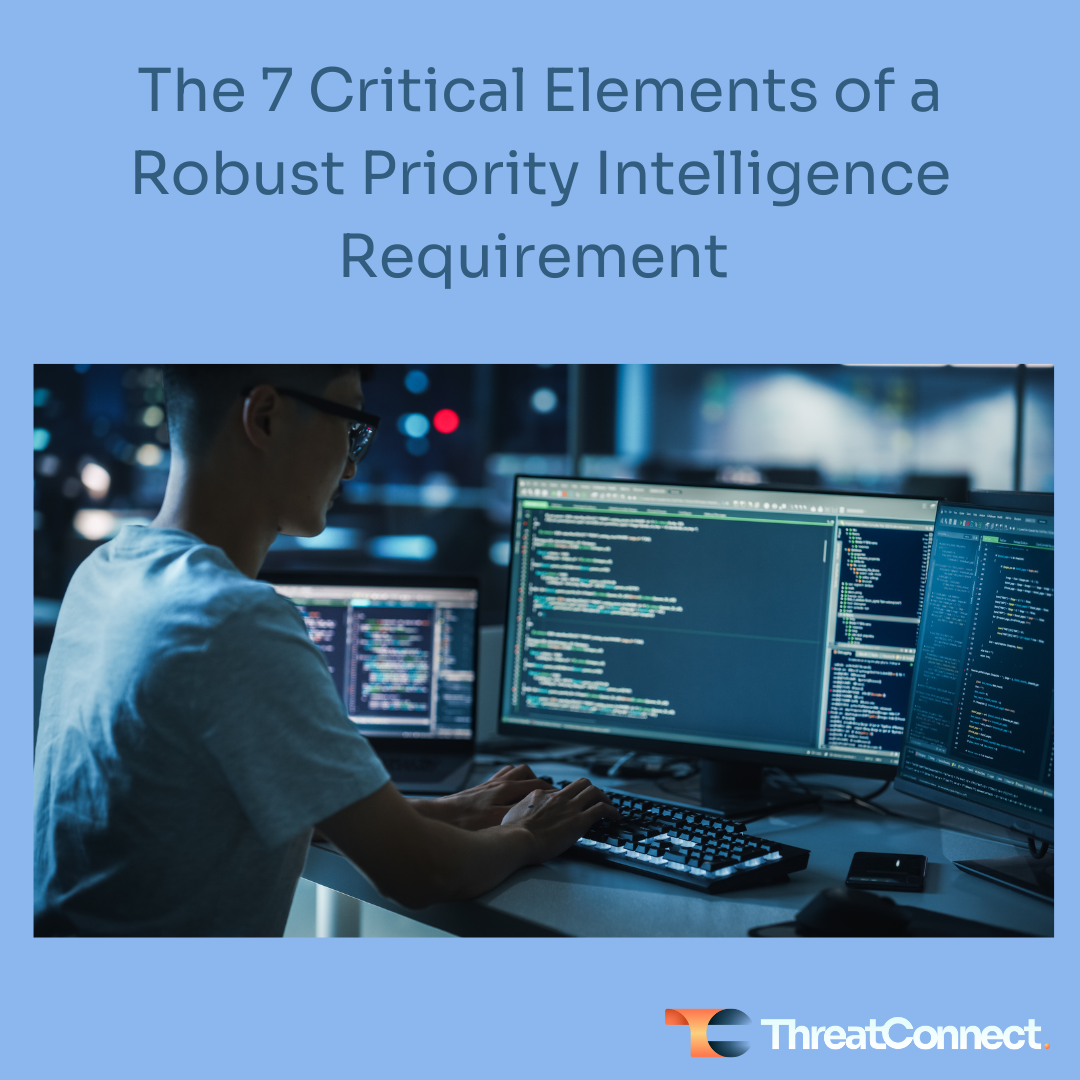Posted
Threat intelligence is crucial in understanding the threat landscape and making informed decisions. Priority Intelligence Requirements (PIRs) are central to effective threat intelligence planning and operations. PIRs enable organizations to prioritize and act upon the most relevant threats, giving focus to the management of threat intelligence. In this blog, we explore the concept of PIRs and the key elements that make them effective in any industry.
Before we dive in, make sure you check out our latest blog on how to build and leverage your PIRs step by step in ThreatConnect’s TI Ops Platform Intelligence Requirements feature. Also, don’t forget to download Operationalizing Intelligence Requirements: A Comprehensive Guide for more in-depth information.
Understanding Priority Intelligence Requirements
PIRS represents the topics or areas of the threat landscape most important to an organization’s mission and objectives. PIRs guide threat intelligence analysts in their collection, analysis, and dissemination efforts, ensuring efficient allocation of resources to address the most impactful threats. Well-written PIRs enable organizations to focus on critical areas of concern, enhancing the effectiveness of their threat intelligence operations and ensuring analysts spend their time on work that genuinely matters.
Critical Elements of a Well-Written PIR
- Clear and Specific Focus: A good PIR should have a clearly defined and specific focus. It should address a threat or intelligence gap relevant to the organization (i.e., risk, mission).
Example: Identify and analyze targeted phishing campaigns aimed at the organization’s executive team (Focus) to mitigate the risk of data breaches or unauthorized access.
- Measurable Objectives: Include measurable objectives the CTI team can use to assess progress and success. Goals should be quantifiable and time-bound, allowing organizations to track their performance in addressing the identified intelligence requirements. Defining these goals helps evaluate the effectiveness of threat intelligence activities and make necessary adjustments.
Example: What threat actors target voting machines ahead of an election (Focus), and what tactics, techniques, and procedures (TTPs) are those threat actors using against those systems (Measurable Objective)?
- Relevance to the Organization: PIRs should align with the organization’s industry, sector, or business model. They should address threats that directly impact the organization’s operations, assets, or stakeholders. PIRs should ensure the intelligence gathered is actionable and relevant to the organization’s needs.
Example: What threats are targeting remote access to OT/ICS systems in the Energy sector?
- Consideration of the Threat Landscape: The current and evolving threat landscape should be considered when creating PIRs, focusing on emerging trends and TTPs employed by threat actors. PIRs should reflect the organization’s understanding of the threat landscape and its proactive approach to staying ahead of potential risks.
Example: Monitor for the latest tactics, techniques, and procedures (TTPs) ransomware operators employ.
- Integration with Compliance Requirements: Regulatory and compliance requirements relevant to the organization’s industry should also be a focus of PIRs. It ensures that the intelligence collection efforts align with the organization’s risk management and compliance obligations and helps identify and mitigate potential gaps with industry standards and frameworks.
Example: The CTI team is aligned with the team responsible for payment card processing through an agreed PIR that ensures relevant intel is provided to the team and that the CTI function meets applicable requirements for PCI-DSS.
- Flexibility and Adaptability: PIRs should adapt to changing circumstances. The threat landscape evolves rapidly, and organizations need to be able to adjust their intelligence requirements accordingly. Proper use of PIRs should be revised and updated as new threats emerge or organizational priorities shift.
Example: Review and update PIRs quarterly to align with emerging threats, industry trends, and organizational priorities, ensuring the intelligence requirements remain relevant and practical.
- Collaboration and Information Sharing: Threat intelligence does not exist in a vacuum; it aims to inform and enable other teams to prevent and mitigate threats. To achieve this, collaboration and information sharing across intel producer and consumer groups is crucial. Involving relevant stakeholders in producing PIRs ensures that they address the real-world threats faced by teams like SOC, IR, red teams, and threat hunters. This collaborative process should include stakeholders from different business units, starting with the CTI and SOC teams and expanding as needed.
Collaboration and information sharing play a central role in leveraging threat intelligence. The effectiveness of threat prevention and mitigation efforts can be significantly enhanced by involving relevant stakeholders, promoting teamwork, and ensuring alignment with organizational goals.
Example: PIR 1 involves the CTI team and SOC’s Threat Detection and Monitoring Team. CTI shares indicators and reports with the team. A monthly meeting reviews PIR scope, intel fidelity, and report relevancy.
PIRs serve as a cornerstone of effective threat intelligence planning and operations. Well-written PIRs allow organizations to concentrate resources, address specific threats, and make informed decisions. PIRs ensure that threat intelligence efforts align with business risks, objectives, and compliance requirements by being transparent, specific, measurable, relevant, and adaptable. Collaboration, consideration of the threat landscape, and flexibility are essential factors in developing robust PIRs that empower organizations to stay ahead of the evolving cybersecurity landscape and set them up for planning their journey through the Evolved Threat Intelligence Lifecycle.
To learn more about how the ThreatConnect Platform can make operationalizing threat intelligence faster, easier, and more efficient, click here to speak with one of our experts or request a demo of our Platform.
Read Next:
To find out more about this topic, check out our:
